


|
|
|||||||||||||||||||||
|
|
 |
|
|||||||||||||||||||
|
|
 |
 |
|||||||||||||||||||
|
|
|||||||||||||||||||||
| Edition 8 |
|
|
|||||||||||||||||||
|
|
|||||||||||||||||||||
|
|
|
|
|
|
|
|
|
|
|
|
|
|
|
|
|
||||||
|
|
|
|
|
|
|
|
|
|
|||||||||||||
|
|
|
|
|
|
|
|
|
|
|
|
|
|
|
|
|
|
|
|
|
|
|
 |
 |
 |
|||||||||||||||||||
| The John Wray McCann Show No one quite remembers how John came to be involved at Turtle, but the day he walked in started a new program style for the Williamstown studio – the “live” to tape talk show in front of a studio audience. The Turtle “studio” was a part of a converted Federation house, where the front room and hallway had been extended with a new addition. The original section of the house, with the higher ceiling, would serve as the studio and the new multi purpose extension as the audience area. The first John Wray McCann Show - 1976 John Wray McCann first became interested in hosting television programs when he won a world trip on the Coles three thousand pound question. The exciting environment of television became the lure that would see him pursue a career as a host, eventually finding his way to Turtle Video. John’s background included writing jokes for people such as Barry Crocker, Mike Preston, Don Lane, Jimmy Hannan and Phyllis Dyller. He was also a poet and had performed his original works on ABC radio and on television, winning a series final on the talent show “New Faces”. So when John first arrived at Turtle he had the idea of combining his comedy and poetry into a talk show format. Working with such a young crew, aged between 16 and 24 must have been a strange experience, but video facilities and crews were still rare and everyone was enthusiastic for the project. |
|||||||||||||||||||||
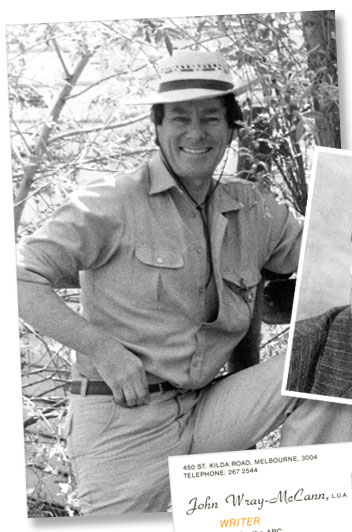 |
 |
||||||||||||||||||||
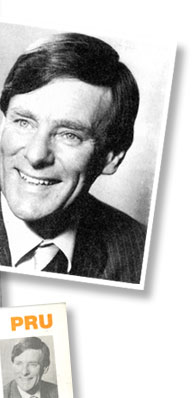 |
|||||||||||||||||||||
 |
 |
 |
|||||||||||||||||||
| John Wray McCann. | |||||||||||||||||||||
 |
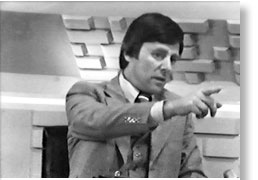 |
 |
For the crew, this would be a very different experience and raised many questions. Most programs to date had used people we knew as the talent – John and his guests were new to everyone. This would be the first time a studio audience of 50-70 people would watch the production recorded “live” to tape - how would the show work as both as a television program and as a live show for the audience?. We would need a host set - and how would the guests enter and exit the set? Johns poetry required music that both he and the audience would need to hear. The set built was a combination of the blue flats that had been made for Channel Four News with alternating lighter coloured panels. One side of the set led out to the hallway where guests could enter and the plastic ‘bowl” lights from the control room hung to one side to break up the background. Seating from the primary school hall was borrowed for the studio audience and speakers run from the control room into the audience area for the music playback. Slowly each difficulty was worked out and eventually the first “John Wray McCann Show” was recorded in July 1976. The second John Wray McCann Show - 1977 Both John and the Channel Four crew looked forward to doing another show. The first program had highlighted many problems and the second show would be an opportunity to iron out those issues. An old Peter Couchman set was borrowed from Channel Ten and transported using the old yellow bus owned by WREC. The 5 or 6 tall columns that made up the set would be arranged in a semi circle providing a full backdrop for both John and his guests. The venue organised was the Maribyrnong High School auditorium – it had a grid with theatre lighting and a cyclorama style background. A full set, a grid full of lights and a large space to work in was exciting prospect for everyone. By this stage National had released a vision mixer that would allow videotape to be run through the mixer “live”. Up until this point that hadn’t been possible as every time you stopped a tape machine using the Sony vision mixer, it would lose sync and breakup uncontrollably. The National mixer was by no means perfect and suffered its own problems, but at the time it was a huge leap forward. Some of Johns poetry segment’s could be pre recorded and act as breaks, allowing guests to enter or exit the set or for other things to be setup during the videotape replays. One large issue had always been audio – this time it was decided to look for outside help, both as a way to ensure a better quality result for the program and as a way to learn more about sound as well. On the 28th of September 1977 an ad was placed in the local paper calling for “An experienced Audio man to operate audio mixer on a pre recorded television tonight show. Not necessarily Channel nine standard, but a good understanding of sound mixing” – no one answered the ad. |
||||||||||||||||||
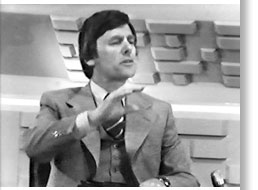 |
|||||||||||||||||||||
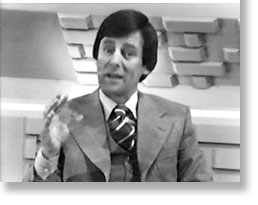 |
|||||||||||||||||||||
| Above - The many faces of John Wray McCann. |  |
||||||||||||||||||||
 |
|||||||||||||||||||||
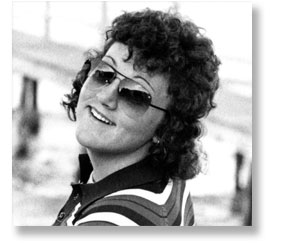 |
|||||||||||||||||||||
| Eveana Ferrera | |||||||||||||||||||||
 |
|||||||||||||||||||||
| Eveana Ferrera, who was a regular at WREC, took on the role and in a pressure situation learned the set up quickly. Everything was now set for the show to be recorded on the 15th of October 1977 but disaster was about to hit. A state-wide power strike was called for the week the show was to be recorded – the auditorium was now unusable due to the power restrictions and everything would need to be reorganised. The show would be delayed to the following week, but unfortunately the auditorium had a prior booking and new space would need to be found. With the change of venue, many of the original plans were no longer possible. The new “studio” was a renovated house with a large open multi purpose area similar to the Turtle studio. It had low ceilings, so the set now had to lie on its side. The low internal metal lined ceiling created a hum through the audio setup and made it difficult to light. There wasn’t enough room to create a wrap around set AND accommodate a studio audience so the whole thing was pushed up against a wall as one flat background. No longer was there a grid full of lights, so three redhead lamps and some borrowed photographic lights lit the set and guests. In spite of the difficulties, the show was recorded on the 22nd of October 1977 from the Western Region Education Centre. |
|||||||||||||||||||||
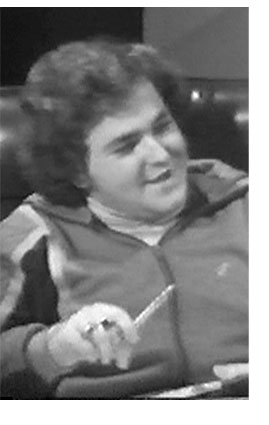 |
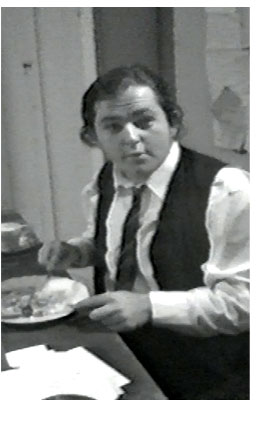 |
||||||||||||||||||||
| L to R - David Grech hosting “The Last Three Years” and in the role of the interrogator in “The Spider and the Fly”. |
|||||||||||||||||||||
 |
|||||||||||||||||||||
| The Last Three Years In 1977 Gary Shaw began planning the huge undertaking that would become “The Last Three Years”. This talk show would also be recorded “live” in front of a studio audience and would cover the first three years of Turtles/Westcoms operation. The centre had recently purchased a National mixer and could now run in tapes “live” and this show would require dozens of tape replays all switched live during the show. Weeks of pre-production, locating and editing all the centres footage, organising the dozen or so guests and pre-recording material led up to the night. Gary asked friend David Grech to front the program – this would be the first time David hosted a “live” television program in front of a studio audience. David had been involved with Turtle Video from the early days of Pier Street Altona. He starred in Small Screens Production's "The Rocky Horror Show" and also played the part of a police man in “Why Me”. Unfortunately his policeman scenes were not used in “Why Me” due to a last minute script change but the footage that was shot was fondly remembered. David threw himself into the role of host, working under difficult circumstances. He went on to play the starring role of the interrogator in Robert Manderson's “The Spider and the Fly”. A number of the planned guests couldn’t be there on the night, so Gary pre-recorded the interviews with host David and replayed them on the night. Deb Manderson and David Page pre-recorded two songs, miming to the audio recordings done at the Yarraville Community Centre with Deb also doing makeup on the night. The original show ran for almost one and a half hours with David having to cope with unexpected answers from guests and technical issues with the tape replays – throughout it all he calmly carried on and warmed into the role. Many of the video clips on this web site have survived as part of the recording of “The Last Three Years”. The set was constructed on the day with whatever was available – chairs borrowed from one source – a table lamp from another. David always had a commitment to excellence and came to us with an impressive resume. He was instrumental in School Productions and local Theatre productions. David also hosted community events and local functions around the Western suburbs of Melbourne. He not only made videos but spread his talents to many Super 8 film activities. David is certainly a face that was well remembered at Turtle Video. |
|||||||||||||||||||||
 |
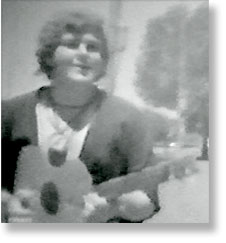 |
 |
|||||||||||||||||||
| David in the "The Rocky Horror Show". | |||||||||||||||||||||
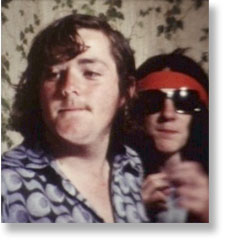 |
|||||||||||||||||||||
| An early super 8 movie. | |||||||||||||||||||||
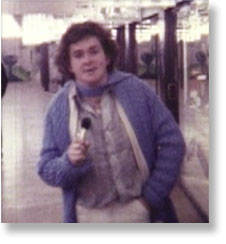 |
|||||||||||||||||||||
| Hosting in the City (Super 8) | |||||||||||||||||||||
|
|
|||||||||||||||
|
|
|
|
|
|
|
|
|
|
|
|
|
|
|||
|
|
|||||||||||||||
|
|
|
Reuniting friends and members of Community Access Video Centres from Melbournes Western Suburbs, Victoria, Australia |
|
|
|||||||||||
|
|
|||||||||||||||
|
|
|
|
|
|
|
|
|
|
|
|
|
|
|
|
|